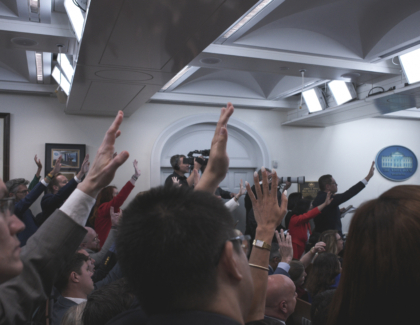Sign up for the daily CJR newsletter.
News literacy as a field is officially about eight years old. For four of those eight years, it has been funded by the McCormick Foundation (which has also funded these stories), whose three-year, $6 million initiative, Why News Matters, is just past its halfway point. As Clark Bell, director of McCormick’s Journalism Program, writes in the latest issue of Continuance Magazine, it’s time to figure out how the news literacy movement can gain traction in years to come.
That traction, according to participants of the News Literacy Summit held in Chicago this past September, will come from building alliances with researchers and educators in adjacent fields. In order to deepen the impact of news literacy, the movement is primarily focused on students and tethered to curricula that already exists in schools or journalism programs. On the K-12 level, civic education and language arts naturally lend themselves to news literacy programming, because they seek to foster critical thinking skills. On the undergraduate level, news literacy tends to be introduced within journalism departments.
This systemic approach to news literacy, however, often excludes news consumers outside of schools. As the “formal” field narrows, it’s important to consider what potential more out-of-the-box approaches to news literacy could have and involve players who work in similar spaces. This may require a broader definition of news literacy than the oft-quoted “teach news consumers to be skeptical of the news, learn how to assess and verify sources, and understand bias.”
That broadening includes concepts like how much context is presented, what time of day people read, how they share stories, how algorithms select stories, how trends emerge differently on different social networks, what type of internet access readers have, and how much they spend on subscriptions, apps, or devices–in other words, what’s typically seen in user engagement research could inform news literacy as well.
In that light, here are some questions worth exploring within and beyond the field.
1. How do headlines change the way we process information?
While plenty has been written this year about clickbait and its impact on traffic, there hasn’t been much study of how it impacts our understanding of events. In a recent New Yorker piece, Maria Konnikova discussed a series of studies published in the Journal of Experimental Psychology: Applied about how slightly misleading shifts in headlines can affect a reader’s ability to recall the details of an article. The idea falls squarely into the larger question of how news can be designed to encourage understanding, which, considering the rise of explanatory news in 2014, is worth further exploration to figure out just how information design impacts literacy.
2. How do we actually measure understanding of the news?
A report published by Engaging News Project and Solutions Journalism Network earlier this year found that “solutions-based” stories impact reader understanding in a positive way. After presenting readers with news stories that contained a solution to an issue as well as those that didn’t, researchers found that most readers “feel” more informed when reading an article that presents an issue along with a solution. As research on the topic continues, figuring out more precisely what type of story structure can maintain journalistic integrity and be conducive to understanding will be critical.
3. How does news trend differently on different social networks and what should we know about algorithms in order to be savvy news consumers?
Towards the beginning of the Hong Kong protests, data scientist Suman Deb Roy published a fascinating piece on Medium about how five different news items trended (or didn’t trend) on Facebook and what factors influence the attention a news story gets. He found three: time of day, competing stories, and “escape velocity,” that is, how high a story reaches on the trending list and how long it stays there. But most research of this sort is limited to the world of data scientists or curious data literate readers. Just as publishers compete to understand (and game) the algorithms ruling networks, news consumers could benefit from the information to decide which social networks to turn to for breaking news, and when.
4. How do we engage more communities around accessing and understanding the news?
Coming up in 2015 is a series of news literacy roundtables organized by the American Society of News Editors and the News Literacy Project. In collaboration with a local educational partner, media partner, and community partner, each group will identify a local news topic of importance as the basis for a dialogue about news literacy, taking the discipline beyond the classroom.
5. Who is the “liminal press” and how do we hold them accountable?
Over at Nieman Lab, researchers Mike Ananny and Kate Crawford wrote an interesting piece about how designers and app developers shape the news. They call this group a liminal press: people and systems existing outside (but alongside) online news organizations that create the conditions under which mobile news circulates. It’s important, they argue, to develop a new ethics of press responsibility that takes into account the divides between software designers and journalists. Just as awareness of editorial slant helps news consumers choose what to read, knowing the motivations and intentions of this “liminal press” can help readers decide how to construct a media diet.
Funding for this coverage is provided by the Robert R. McCormick Foundation.
Has America ever needed a media defender more than now? Help us by joining CJR today.






